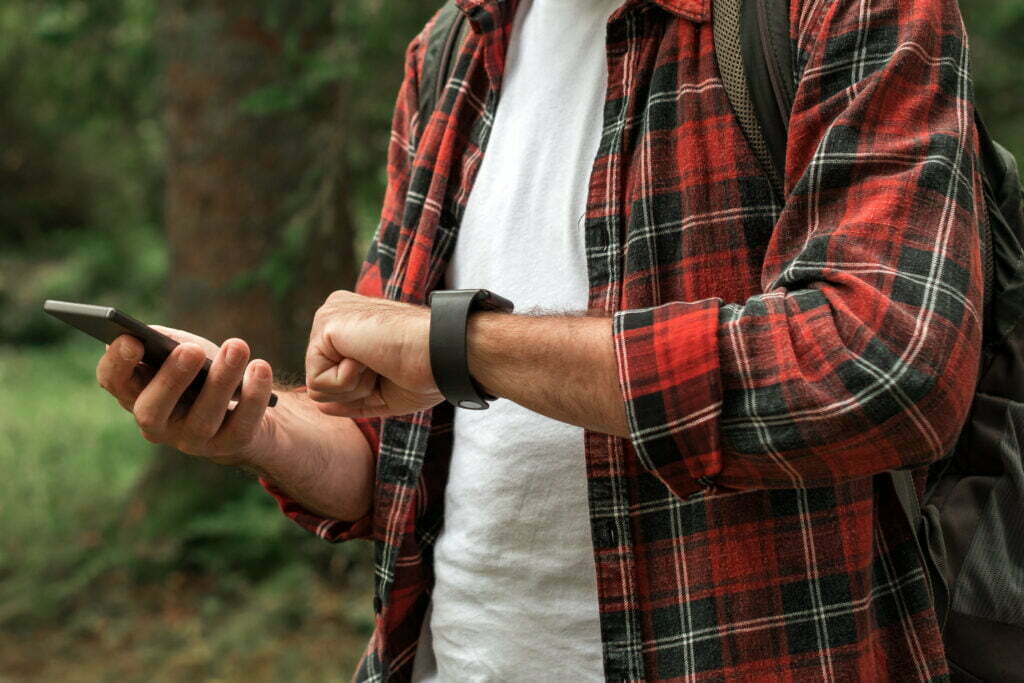Who would have thought that a simple wristwatch could turn into a wearable healthcare monitoring device?
Wearable Devices
“With the use of wearable devices, patients are empowered to be more involved in managing their health,” says Dr. Kelly Nguyen, CEO, and Founder of DrKumo, Inc., when asked why use wearable devices in RPM.
Wearable devices are electronic devices usually used to track users’ health. It may be in the form of accessories, clothes, or even tattoos.
Over the years, wearable devices had greatly developed due to the dramatic need for real-time monitoring of long-term health conditions especially when the Covid-19 health crisis hit globally. During this health crisis, patients with chronic diseases had become very vulnerable to cross-infection limiting their access to medical care from clinics and hospitals. Although existing for several years, wearable devices surged during the Covid-19 pandemic due to the overwhelming demand for monitoring vulnerable patients remotely.
Wearable devices used as healthcare tools have two main roles. The first is for disease prevention and health maintenance, such as physical activity monitoring. The second is for patient and disease management.
One of the most-used wearable devices is the smartwatch. This will be the focus of this article.
Smartwatch
As early as 1965, a fitness tracker watch called manpo-kei, 10,000-step in English, has already surfaced. It was invented by Dr. Yoshiro Hatano, a Japanese professor at the Kyushu University of Health and Welfare, to combat obesity.
A fitness tracker was invented to bridge the gap between patients who have access to aggressive weight-loss treatment and to those who do not. From a fitness tracker, the smartwatch industry has paved its way to becoming a highly marketable healthcare monitoring device. As such, the fitness tracker industry stepped-up and introduced the first wireless heart rate monitoring embedded in the Polar watch in the 1980s. From then to this date, the smartwatch industry shows no signs of slowing down.
Smartwatches have different features. One smartwatch may have several and different features and the other may be designed to monitor specific illnesses. Here are some common features of smartwatches.
Smartwatch as Heart and Respiration Rate Tracker
Smartwatch with heart rate tracker measures electric pulses or signals from the heart using heart rate sensors. A heart rate sensor on a smartwatch utilizes photoplethysmography (PPG). This PPG is an optical technique that detects volumetric changes in the blood caused by peripheral pulses which can be measured at the surface of the skin and will then be used to estimate the heart rate. The same sensor is used to measure the user’s respiratory rate- the number of times the user inhales in one minute.
Smartwatch with heart and respiratory rate tracker aims to give users insight into their fitness level.
Smartwatch as Electrocardiogram (ECG) Monitoring
Smartwatch with an ECG monitoring feature measures the electrical activity of the heart that travelled to the skin. Usually, two sensors are being utilized to monitor blood pressure (BP) in a smartwatch. These are the ECG sensor and PPG sensor. The ECG sensor is usually located at the side or face of the smartwatch while the PPG sensor is located at the back of the smartwatch touching the user’s skin.
To determine the blood pressure of the user, he must press the ECG sensor with his finger. The ECG sensor will record each pulse. The pulse will then travel from the heart to the wrist where it will be detected by the PPG sensor. The time travelled by the pulse from the heart to the wrist will determine the blood pressure of the user. If the time travelled is faster, the blood pressure is higher and vice versa.
Smartwatch with an ECG monitoring features aims to enable user to monitor the health of his heart. It also aims to notify both the user and his doctor when an irregularity in his heart rhythm occurs. This may reduce stroke attacks and even untimely deaths caused by high blood pressure.
Smartwatch as Electrodermal (EDA) Tracker
Smartwatch with EDA feature is usually used to monitor stress, pain, and sleep. This measures the continuous variation in the electrical characteristics of the human skin which is dependent on the changes of the sympathetic part of the autonomic nervous system. The EDA of a person changes when aroused or excited, as such, it may measure emotional responses, anxiety, stress, or pain.
A smartwatch with EDA is usually given to a patient with depression or anxiety attacks.
Smartwatch as Sleep Tracker or Actigraph
A smartwatch with a sleep tracker monitors the user’s sleep duration and sleep quality based on his body movements, heart rates, and external noises. For the sleep duration, the device will track the length of time when the user goes inactive at night and the moment he starts to move in the morning. For the sleep quality, the device will detect any interruption in the user’s sleep. Some devices will also record environmental factors such as the room lighting, temperature, and surrounding noises which may affect the user’s quality of sleep.
Smartwatch with a sleep tracker or actigraph, combined with the EDA feature, is given to a patient to monitor his level of stress.
Smartwatch as Blood Oxygen Tracker
Smartwatch with blood oxygen tracker usually used SpO2 sensors to measures blood oxygen level or saturation of oxygen in the blood. Using infrared light, the device will measure the difference between the light emitted and the light reflected when the device’s sensor to determine the blood oxygen level of the user. This may be measured in the chest or wrist.
A smartwatch with a blood oxygen tracker is usually given to patients with respiratory illnesses like sleep apnea, emphysema, chronic inflammatory lung disease, or Covid-19.
Smartwatch for Patients with Alzheimer’s or Dementia
People living with Alzheimer’s or dementia regularly experience temporary or permanent memory disorientation. This causes them to forget faces, names, and places even their homes, often leading to wandering off. Fortunately, GPS tracker was integrated into smartwatch to address this concern. This locator allows patients with Alzheimer’s or dementia to be found whenever they wander off.
Similarly, smartwatch with GPS tracker was also designed for children. This enables parents to track the whereabouts of their children.
Smartwatch as Medical Alert
Some smartwatches can detect falls. These smartwatches with fall detection have a built-in algorithm that can detect when the user falls.
The accelerometer and gyroscope sensors embedded in the smartwatch can detect falling motion. After a falling motion, the smartwatch will sound an alarm or display an alert message on the watch’s face. If the watch detects no movement from the user for a certain period, it will call emergency services and provide the user’s location. It will also send the same message to all the user’s emergency contacts.
Some smartwatches were also designed to vibrate to awake the user when it detects low blood oxygen level or irregular heartbeat while the user sleeps.
DrKumo’s Smartwatch
DrKumo’s top-of-the-line smartwatch is part and parcel of DrKumo, the leader in next-generation RPM. It is bundled with numerous features such as BP, SpO2, respiratory rate, heart rate, body temperature, and ECG monitoring to remotely monitor patients with chronic diseases. This life-saving smartwatch collects biometric data through its sensors. The data collected is transmitted to the user’s smartphone. From the smartphone, the data collected will travel to the cloud database, where it may be stored and accessed by the healthcare provider.
Although capable of numerous features, this state-of-the-art smartwatch continuous to innovate.
RELATED ARTICLE: How Bluetooth Works in Remote Patient Monitoring
The Future of Smartwatch in the Medical Field
Wearable technologies, such as a smartwatch, capable of real-time healthcare monitoring is the new norm today. From a basic time-teller to a fitness tracker to a healthcare monitoring device, a smartwatch’s capabilities are not measured to what it can do today but to what it can offer tomorrow.
Numerous studies are being conducted to explore a wider potential for this wearable device. A wide range of information to improve patient care is just waiting to be studied and applied. Shortly, a smartwatch may be used to rehabilitate drug abuse patients, to detect and monitor patients with Parkinson’s and cancer, and so on. After all, the only limitation in the advancement of technology is one’s imagination.
References:
- Electrodermal activity. Wikipedia. https://en.wikipedia.org/wiki/Electrodermal_activity
- Handberg, E. and Massoomi, M. (2019 December 18) Increasing and Evolving Role of Smart Devices in Modern Medicine. ECR. https://www.ecrjournal.com/articles/increasing-and-evolving-role-smart-devices-modern-medicine
- Isakadzea, N. and Martin, S. (2020 October) How useful is the smartwatch ECG? Science Direct. https://www.sciencedirect.com/science/article/pii/S1050173819301495
- Phaneuf, A. (2021 January 12). Latest trends in medical monitoring devices and wearable health technology. Insider. https://www.businessinsider.com/wearable-technology-healthcare-medical-devices
- Baig, E., (2020 September 28) Newest Smartwatches Move From Tracking Fitness to Monitoring Health. AARP. https://www.aarp.org/home-family/personal-technology/info-2020/smartwatches.html
- Kay, M. and Charlton, A. (2021 February 02) These are the smartwatches and wearables that can take an ECG in 2021. Gearbrain. https://www.gearbrain.com/heart-monitor-device-ecg-2628506620.html









